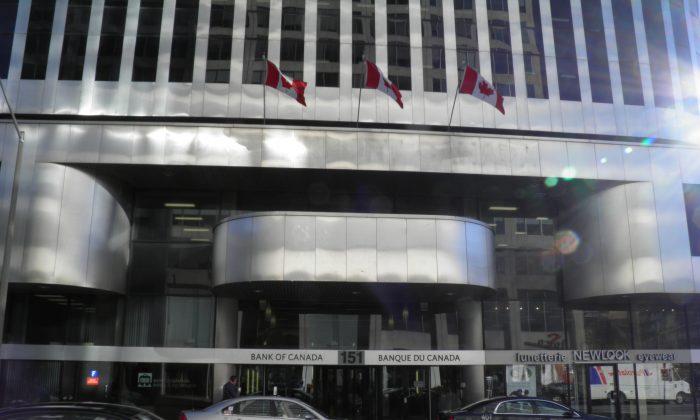OTTAWA—As widely expected, the Bank of Canada kept its target for the overnight rate at 1 percent on Wednesday, as inflationary pressures remain subdued and the growth outlook for Canada remains similar to that in the prior Monetary Policy Report (MPR) from mid-July.
The central bank, in its final MPR of the year, projected growth (real GDP) averaging about 2.5 percent in 2015 before falling to 2.0 percent in late 2016. Inflation (total CPI) is very close to the 2.0 percent target and is projected to remain as such until the end of 2016.
The statement didn’t include mention of a “neutral” stance with respect to the direction of the next move in rates. Regarding this forward guidance, the Bank doesn’t believe there are net benefits to its use presently. “There will no doubt come a day when we will offer forward guidance again—but not on this day,” said Governor Stephen S. Poloz in his opening statement which was to precede the MPR press conference.
The press conference that follows the release of the MPR was canceled due to shootings near Parliament Hill.
Market reaction to the announcement included a slight move higher in Canadian government bond yields and the Canadian dollar climbed back into positive territory after a plunge before the announcement.
Offset by falling energy prices and excess capacity in the economy, inflation was boosted temporarily by items such as telephone and Internet services and meat. The depreciation of the Canadian dollar, which is trading near five-year lows, “appears to be adding about 0.1 to 0.3 percentage points to core inflation at this point,” according to the MPR.
The Bank’s commodity price index has fallen more than 10 percent since the July MPR, with energy 15 percent lower and non-energy commodities 5 percent lower.
The Bank assesses that, while lower oil prices help consumers, overall it would be negative for the economy due to its effects on the terms of trade and domestic incomes. The longer-term threat is to investment in the oil sector, which has an entire supply chain that is vulnerable and reaches across the country.
Despite the weakness in the global economy, notably in Europe and China, the U.S. economy remains relatively stronger, which has helped Canadian exports. Lower oil prices and a weaker Canadian dollar have helped the competitiveness of Canada’s non-oil exports. According to the MPR, the third quarter should see a further gain in exports.
The Bank doesn’t project oil prices and assumes a level of the average price over the last several days when making its economic projections. Similarly, for the October MPR projections, the Canadian dollar is assumed to remain at 89 cents over the projected horizon versus 93 cents in July.
Labor Market and Economic Slack
The economy is projected to reach its full capacity in the second half of 2016, but material slack (estimated at between 1 and 2 percent) is currently evident.
While the unemployment rate has declined to 6.8 percent, a six-year low, “it likely overstates post-recession improvement in the labour market,” the MPR says. The Bank’s more comprehensive labor market indicator is roughly 0.5 percent higher than the unemployment rate.
The weakening global economic outlook and weaker commodity prices are contributing to the labour market slack.
In its projections for global economic growth, the Bank of Canada sees U.S. growth rising to 2.9 percent in 2015 and 2.7 percent in 2016, whereas the Euro area is expected to grow at 0.8 percent in 2015 and 1.0 percent in 2016. Of note, China’s growth is expected to begin to slow considerably, falling from 7.4 percent this year, to 7.0 percent in 2015, and 6.9 percent in 2016.
The Bank points out that “growth remains reliant on exceptional policy stimulus.”
Housing Risks
A soft landing is still the most likely scenario for the evolution of the housing market. With mortgage rates lower than at the start of the year, housing is providing a boost to economic activity, but the cost is the rising levels of household debt. The Bank characterized the financial stability risks from housing imbalances as “edging higher.” The Bank is not seeing the “constructive evolution” it once used to, but is not calling for any immediate action.
With the rise in house prices being driven by Toronto, Vancouver, and Calgary while the rest of the country remains soft, resale activity moving higher than the 10-year average hasn’t translated into rapid indebtedness increases as homeowners have equity in their homes and don’t need to borrow as much.
Household credit growth is now also getting a boost from car sales, which have hit a record high.
The Bank of Canada’s next interest rate announcement date is Dec. 3 with the next full economic projections and MPR to come Jan. 21, 2015.





